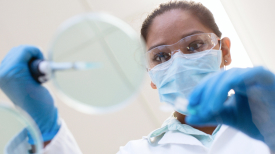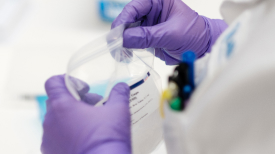- Cancer Care Team
Cancer Care Team
To deliver optimal patient outcomesProducts and Services
Cancer Type
Supplies & Tools
Scientific Focus
- Biopharma Partners
- Patients
- Education & Events
- Login
- Contact Us
Test Details
 Cancer Type
Cancer Type
Hereditary cancer
 Technology Used
Technology Used
Molecular, NGS
 Turnaround Time
Turnaround Time
20 - 28 days
Use
This assay is intended for patients with a history consistent with Multiple Endocrine Neoplasia, type 2.
Genes included: RET
Special Instructions
A hereditary cancer clinical questionnaire should be submitted with all specimens. Contact CMBP genetic services at 800-345-4363 to coordinate testing. To order Oragene Dx 500 saliva collection kits using PeopleSoft No. 87917, contact your local Labcorp branch supply department.
Limitations
Sequencing cannot detect variants in regions not covered by this analysis, including noncoding or deep intronic variants and may not reliably detect changes in repetitive elements, such as microsatellite repeats. Sequencing may not detect mosaic variants, inversions, or other genomic rearrangements such as transposable element insertions. Sequence analysis may also be affected by allele drop-out due to the presence of a rare variant under a primer site or homopolymeric regions. The method does not allow any conclusion as to whether two heterozygous variants are present on the same or on different chromosome copies.
Copy number analyses are designed to detect single exon, multi-exon, and full gene deletions or duplications. These analyses may not detect certain genomic rearrangements, such as translocations (balanced or unbalanced), inversions, or some partial exon rearrangements. This assay cannot determine exact breakpoints of deletions or duplications detected.
The presence of pseudogenes can interfere with the ability to detect variants in certain genes. For example, deletion/duplication analysis of PMS2 exons 11-15, among others, is complicated by the highly homologous PMS2CL pseudogene. Deletions/duplications in PMS2CL have not been associated with Lynch syndrome, however this assay may not be able to determine if a deletion/duplication affects PMS2 or PMS2CL.
Each gene sequence is interpreted independently of all other gene sequences; however, variants in different genes may interact to cause or modify a typically monogenic disease phenotype.
In addition, the presence of an inherited cancer syndrome due to a different genetic cause cannot be ruled out. Any interpretation given should be clinically correlated with available information about presentation and the patient's relevant family history.
This test is not intended to detect somatic variants. Bone marrow transplantation may affect the outcome of these results. Please contact Labcorp at 1-800-345-GENE to discuss testing options.
This test was developed and its performance characteristics determined by Labcorp. It has not been cleared or approved by the Food and Drug Administration.
Methodology
The coding region and flanking splice sites are analyzed by NGS (+/-10bp) and deletion/duplication analysis. Exon-level deletions/duplications are assessed by aCGH. Clinically significant findings are confirmed by Sanger sequencing or qPCR. Results are reported using ACMG guidelines and nomenclature recommended by the Human Genome Variation Society (HGVS).
Related Documents
For more information, please view the literature below.
Clinical Questionnaire for Hereditary Cancer
VistaSeq® Hereditary Cancer Panels Assay Details
Specimen Requirements
Information on collection, storage, and volume
Specimen
Whole blood or saliva collected in an Oragene Dx collection kit
Volume
10 mL whole blood, 2.0 mL saliva
Minimum Volume
7 mL whole blood, 0.5 mL saliva
Container
Lavender-top (EDTA) tube or yellow-top (ACD) tube or Oragene Dx 500 saliva collection kit
Storage Instructions
Room temperature or refrigerated
Causes for Rejection
Frozen specimen; leaking tube; clotted specimen; grossly or hemolyzed specimen; quantity not sufficient for analysis; incorrect anticoagulant; saliva collection in an incorrect container. Do not eat, drink, smoke, or chew gum 30 minutes prior to saliva sample collection. See Oragene Dx 500 saliva kit for detailed instructions.
Collection
Blood is collected by routine phlebotomy. Saliva is collected by spitting into the provided container until it reaches the fill line.
Related Tests
Find more tests related to this one.





